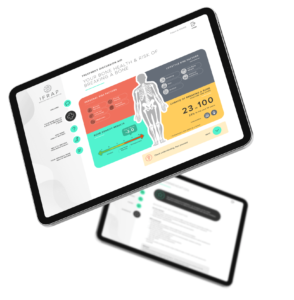SHARED DECISION MAKING
What is shared decision making?
Question
Which of the following statements do you think defines shared decision making?
Select one of the following answers
The process of bringing together scientific evidence and patient values and preferences
The clinician and patient working together to solve a problem and/or make a decision
A process in which people work together with clinicians to select tests or treatments.
All of the above
Further information on the NHS England perspective
can be found here
Also on Ian Hargrave’s broader definition of ‘Purposeful’ Shared decision making, where the clinician and patient working together to solve a problem here. Click here to read
This short video explains further what shared decision making is and why it is important
Let’s think about the terms used in these different definitions, in the context of osteoporosis.
Scientific evidence
The evidence for benefit and harms of osteoporosis drugs is complex even for clinicians to understand. There are also conflicting sources of evidence about benefit and harms. Clinicians need to make this understandable and give clear accurate and consistent information. Later on, we will discuss communication of risk and explain the evidence underpinning the iFraP tool
Patient values and preferences
Sometimes clinicians feel they are already skilled at shared decision making and are good at explaining risks and benefits clearly. However, research across a range of conditions and contexts shows that shared decision making often does not occur well in consultations. This often relates to not finding out what the patient wants or thinks.
Let’s explore what thoughts people newly diagnosed with osteoporosis might have...
Question
How might these thoughts affect the patient’s beliefs and behaviours?
Select one response for each quote
"I’ve been told I am at ‘high risk’ of fracture"
Patient 1
"Well it’s my age, it’s all part of wear and tear"
Patient 2
SOLVING A PROBLEM
NHS England define shared decision making as occurring when people experience a change in their health. A patient who attends an appointment about their bone health may not feel that their health has changed, nor that they have a ‘problem’ or a decision to make.
As osteoporosis can be a silent condition, and osteoporosis medicines are more related to prevention of fractures rather than treating symptoms, the clinician needs to help the patient understand ‘the problem’ and help the patient recognise the decision.
SELECTING TESTS OR TREATMENTS: TALKING ABOUT OPTIONS
Also patients want to know:
Where guidelines recommend one medicine e.g. oral bisphosphonates, you may not feel that ‘choice’ or discussing or selecting options is a relevant concept. However, even if only one medicine is recommended, there are still options, and having options is important to patients. Not taking a recommended drug is an option.
What options are available if I don’t take or don’t tolerate recommended drug treatment?
Patient
Click on the arrows below to find out about Anne’s story:
10 years ago I fractured my wrist
My doctor told me to take alendronic acid. It didn’t suit me, I had terrible indigestion. I stopped taking it. I never went back to my GP because I thought there was nothing she could do for me.
I had 6 years without any treatment then I started getting back pain. Now I have got 4 fractures in my spine.
All I keep thinking is could these fractures have been prevented if I had known there were other options?
Shared decision making is not just about offering choices but working with the patient to meet their needs and enhance their understanding of the situation.
Why is shared decision making important?
Patients want it
People want to be more involved than they currently are in making decisions about their own health and health care. In a national survey of patient priorities in osteoporosis of over 1000 people, improving access to information from health professionals was rated as the highest priority.
NICE and NHS England recommend it
NICE recommend that shared decision making should be embedded in routine care in all healthcare settings. The NHS Long Term Plan says personalised care will become business as usual across the health and care system, based on ‘what matters’ to people and their individual strengths and needs. It sets out a comprehensive model of personalised care, with shared decision making as one of six key parts of the whole model.
Shared decision making improves outcomes
See below
SHARED DECISION MAKING IMPROVES OUTCOMES
Question
What outcomes do you think shared decision making improves?
Click on the boxes to find out more:
Decisional conflict refers to how sure, or unsure someone feels about their course of action e.g. about taking medicine. If someone has reduced decisional conflict this means that if people decide to take recommended medicine, they are more likely to commit to it and adhere over the longer term. Studies have shown that where decision aids are used to support shared decision making for prevention medicines, that patients are more likely to take the recommended medicine.
The patient’s ability to understand their chance of future fracture and side effects associated with medicines. If someone accurately understands their risks, then they are more likely to make an informed decision that’s correct for them
The patient’s understanding of their bone health and why it’s important. By understanding their condition, patients can be supported to make informed decisions that are right for them.
Patient participation refers to how involved patients are in the consultation. Patients that feel involved in their decisions are more likely to take medicines long term.
There is some evidence, for certain conditions and medicines that shared decision making improves clinical outcomes such as medicines adherence. For example, using shared decision making approaches has been shown to increase adherence to asthma medicines and using decision aids has been shown to increase uptake of preventative medicines for stroke.
When to use shared decision making?
Sometimes clinicians feel that they are already doing shared decision making, or that shared decision making is not always appropriate or feasible.
Watch this short video which challenges these ‘myths’
Question
When is shared decision making not appropriate?
SHARED DECISION MAKING IS APPROPRIATE...
When patients do not have full capacity e.g. cognitive impairment..
- Shared decision making may still take place with family and carers.
- Also, in people with limited capacity it is often still possible for you to understand what matters for that patient and incorporate their values.
When a patient makes a decision at odds with clinical guidelines..
- You should present information to patients in the most transparent and understandable (rather than persuasive) way and accept that a patient’s decision on their own care may differ, and is informed by their values as well as the evidence presented.
When patients do not want to participate in shared decision making.. .
- Even if people do not want to participate in sharing a decision, you can use the principles of shared decision making to ensure information we present is relevant to their values and preferences, and understandable.
How to use shared decision making
There are a number of different models of shared decision making. We are going to use the SPIKES model, which was developed for giving bad news but is relevant to any situation where information is shared. The graphic below shows what SPIKES stands for.
SP
IK
ES
click on the boxes to find out more
Includes setting the scene and preparation before the consultation
Finding out what the patient already knows
Asking if it is ok to share information now and establishing shared decision making preferences
Share information, building on existing perceptions and checking for understanding
Use active listening to explore emotions and give empathy
Summarise and plan the next steps
SPIKES MODEL
S - SETTING AND PREPARATION
Preparation can begin before the consultation.
Click on the arrows to find out about Lucia and her experience:
Lucia attended the Fracture Liaison Service. She knew she was going to have a bone density scan and possibly a blood test because she received a leaflet. She prepared for this and knew the right clothes to wear for the scan.
She didn’t know she was going to receive a diagnosis or treatment recommendation. When the clinician started explaining the diagnosis she felt anxious and found it hard to take it all in.
When she got home she thought of lots of questions. She wished she had have been able to prepare. She decided not to take the recommended medicine.
Feeling unprepared can lead to feelings of anxiety and make it hard to take information in, process it and ask questions. Lucia’s situation could have been improved by her receiving more information about what would happen in a Fracture Liaison Service, before her appointment.
Preparation can begin before the consultation.
Click on the arrows to find out more:
At the beginning of the appointment, it’s helpful to check in with the patient and confirm you both have the same expectation of what’s going to happen’
As well as preparing the patient, it is important that the clinician is prepared as well. Patients feel much more comfortable if they can tell you have read their notes beforehand.
SPIKES MODEL
P - PERCEPTIONS
Everyone has different knowledge, experience, preferences and values. Sometimes patients volunteer their previous experience and knowledge, but often they don’t.
Question
WHAT QUESTION OR QUESTIONS COULD WE ASK TO FIND OUT WHAT PEOPLE ALREADY KNOW ABOUT A CONDITION SUCH AS OSTEOPOROSIS OR WHAT PEOPLE THINK ABOUT THEIR OWN BONE HEALTH?
Next you might want to consider what people already know about their diagnosis.
Question
Let’s ask see what happens when we ask ‘what are your thoughts about osteoporosis?’ to Julie, Terry and Ajay.
Read each quote and then try and match the right description of the patient’s beliefs and preferences in the grey panel.

My mother has osteoporosis and I cared for her after her spinal fractures. She was very hunched over and disabled. Nobody helped her. I don’t want to have the same experience she had.
JULIE

My wife’s friend has osteoporosis. She has tried 3 drugs and they made her really sick. I wouldn’t touch a bisphosphonate with a barge pole.
TERRY

I already have umpteen medical conditions I don’t want another one. I am not sure what osteoporosis is. I don’t want to ask because I feel stupid.
AJAY
SPIKES MODEL
I - invitation
You can establish shared decision making preferences by asking
"How do you feel about being involved in making decisions about medicines"
"Are you the sort of person that likes to know the pros and cons indetail before making a decision, or prefers to be guided?"
"Do you prefer to know the details or the big picture?"
Sometimes you will encounter a patient who reacts to these questions by saying something like:
‘Can you tell me what’s best?’’
Shared decision making includes finding out what is important to the patient and making the discussion relevant to their life, beliefs and values.
Patients who are told what to do, or ask for the ‘big picture’ only, might initially follow the recommended advice, but then later question why the advice was relevant to them, or later develop concerns that they were not able to voice at the time.
If a patient asks you to tell them what’s best you could say:
‘I’m happy to share my views on this treatment, but I don’t know all about your life and what works for you, so I will talk you through the pros and cons of the options so that you understand them better and can imagine how they might affect you’
If people don’t seem to want details you could say
‘I’ll run through things briefly now, but then give you a leaflet with the information in, in case you want to refer to it later’
Another possible response to this invitation might be someone who reveals they have something else on their mind and doesn’t feel ready to take information in now. If this happens, then it is best to explore when might be a better time.
SPIKES MODEL
k - Knowledge
When we share information, we are building on what people already know – their ‘perceptions’. If you have started by asking questions about their perceptions you can:
- ‘fill in the gaps’ – which might potentially save time if there are bits of standard explanation you don’t need to give
- avoid patronising people by telling them something they already know
- pick up on what is important to people, and what they may be concerned about, which helps people feel valued, feel that the conversation is relevant and means they are more likely to engage, both by asking questions and may also engage more with recommended treatments
- use language which they have used so that our explanations mean something to them
- gently challenge views which might be considered ‘misconceptions’
Any information you give should be clear, in small amounts, and checking understanding. Chunk and check can be used to promote understanding. When we speak to patients, often there is a lot of information to be discussed and people can struggle to take on board a long list of things. Chunk and check means that the information is broken down into smaller chunks. Checking understanding is an important component of sharing knowledge and we will cover this in more detail the heath literacy section below.
Imagine you were going to explain osteoporosis to Julie and Ajay. Think about how you might tailor your explanations for different people.
Below is a reminder of how they responded.

My mother has osteoporosis and I cared for her after her spinal fractures. She was very hunched over and disabled. Nobody helped her. I don’t want to have the same experience she had.
JULIE
Question
What might your explanation to Julie include or focus on?

I already have umpteen medical conditions I don’t want another one. I am not sure what osteoporosis is. I don’t want to ask because I feel stupid.
AJAY
Question
What might your explanation to Ajay include or focus on?
Let’s consider how to challenge views that we might consider are ‘misconceptions’. Remember people are entitled to their beliefs and generally do not like to be told they are wrong.
Let’s think about Terry who, when asked about his perceptions of osteoporosis earlier, told us that he ‘wouldn’t touch a bisphosphonate with a barge pole’ highlighting that he had high concerns about medicines.
What might be the best approach for you to take?
Select one of the following

My wife’s friend has osteoporosis. She has tried 3 drugs and they made her really sick. I wouldn’t touch a bisphosphonate with a barge pole.
TERRY
Let’s see how that conversation might look
"You mentioned you wouldn’t touch bisphosphonates with a barge pole – can you tell me a bit more about that?"
"Yeah – the acid rots your gullet doesn’t it? I’ve already got really bad indigestion so I don’t want that to happen."
"Oh ok. Yes they can sometimes make indigestion worse if they are given by mouth. There is an option to give bisphosphonates by injection instead which means the medicine does not go into the gullet but gets absorbed straight into the vein. How would you feel about that?"
"Oh I didn’t know that, yes that would be ok"
In this case, the clinician does not directly challenge Terry and say his assertion that ‘acid rots your gullet’ is wrong, and even agrees with him ‘yes’ before offering a slightly different explanation and offering an alternative.
SPIKES MODEL
E - Empathy
Showing empathy is an important part of building the clinician-patient relationship
How can you build empathy?
- Active listening – trying to understand what they are thinking and feeling by:
- Asking open questions and listening intently to their replies
- Responding appropriately – by acknowledging or exploring
- Reflecting back what they have said and summarising to show you are listening and help them to open up more
- Body language – turned towards the person, using eye contact
- Acknowledging distress and concern ‘I’m sorry you’re feeling like that’, ‘that must be really difficult for you’; ‘I understand you’re concerned about that’
SPIKES MODEL
S - Strategy and summary
The strategy in the iFraP consultation is to present the treatment options (which include the option of doing nothing and the possible outcomes of that).
Asking about the patient’s decision
When options have been discussed it is appropriate to ask patients about their thoughts and preferences and their decision. This may help them to make a commitment but will also help them to voice indecision or concerns e.g.
How comfortable are you with this medicine we’ve talked about?
You could ask patients to rate their level of comfort, and/or ask if the patient is willing to take the recommended option, prefers not to take it or if they are still unsure. If they are not feeling comfortable with the medicine discussed, or are unsure, a probing question can explore what unanswered questions they still have. You can ask what additional support they might need then signpost additional resources, suggest they speak further with their GP, family or friends and/or arrange a follow up to discuss further.
At this point it might be tempting to offer further persuasion about medicine.
Remember that persuasion can have the opposite effect than that intended.
However, it might be appropriate to explore any regret they may feel if they do not follow the recommended action, for example
How would you feel if you decided not to take a treatment and later you broke another bone in your spine – would you be comfortable to accept that, or wish you’d taken the drug? For some people worries about side effects are much more important – you will know what matters most to you
Summarising and increasing commitment to treatment plans
Summarising the consultation can help with reinforcing understanding. Some research literature suggests that by asking patients to identify why the medicine is important or relevant, it may increase their commitment to taking treatment. For example you might summarise and ask..
We have talked about these reasons for taking the medicine, to strengthen bones and lower the risk of hip and spine fractures. Which of these reasons is important to you?
It is important to check understanding as part of the summary, this is covered in the next section, and check for any unanswered questions or concerns.
Also, make sure that patients are informed about how information is shared within healthcare teams and among those who will be providing their care.
You have now completed this section
Click below to move to Addressing health literacy
